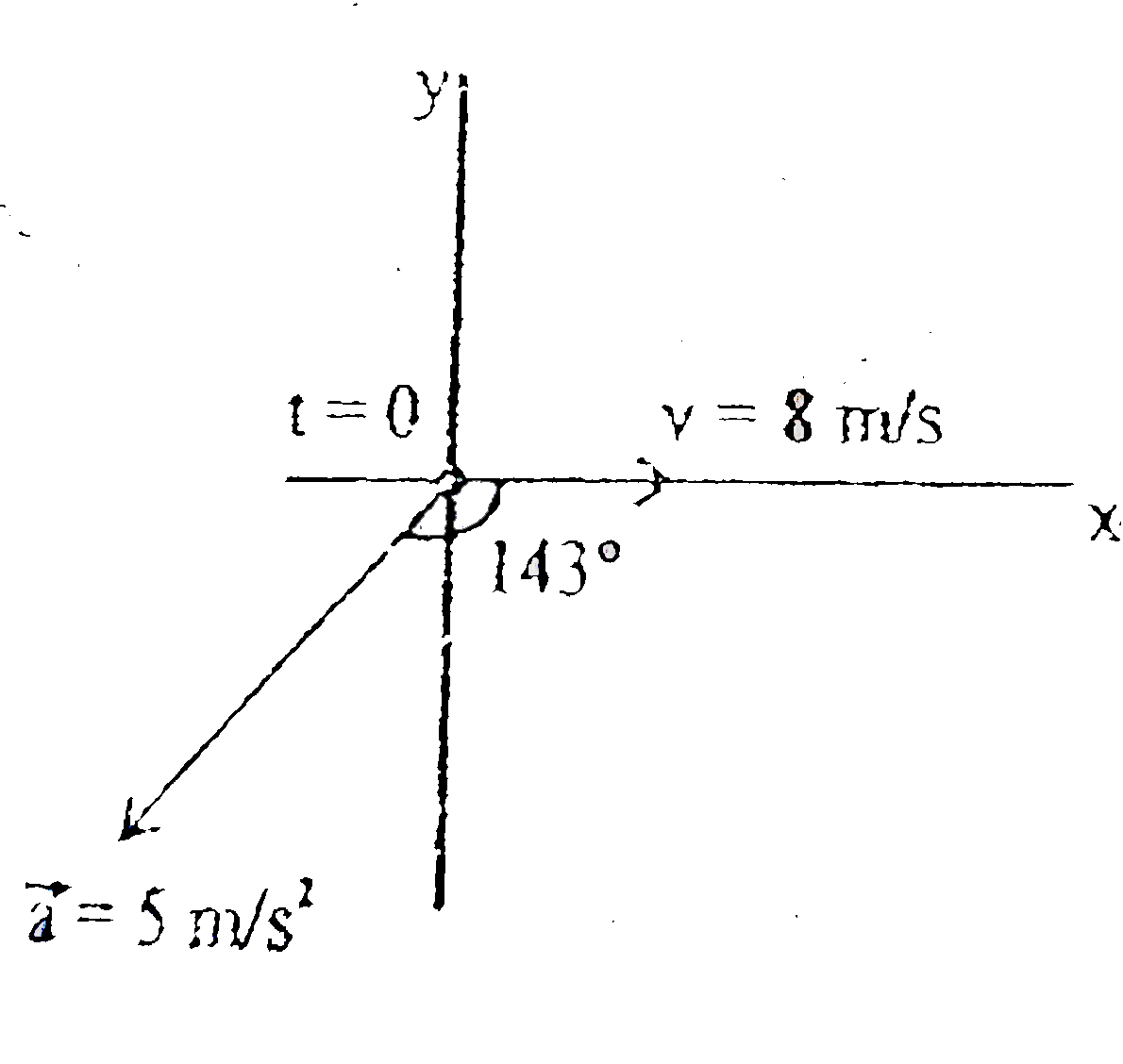A particle moves in the x-y plane with the velocity ¯v=aˆi−btˆj. At the instant t=a√3/b the magnitude of tangential, normal and total acceleration are _&_.
The correct Answer is:√3b/2,b/2,b
To solve the problem step by step, we will analyze the motion of the particle given its velocity and find the tangential, normal, and total acceleration.
Step 1: Identify the velocity vector
The velocity of the particle is given as:
¯v=a^i−bt^j
This means that the x-component of the velocity is a and the y-component is −bt.
Step 2: Find the velocity at the specific time
We need to find the velocity at the instant t=a√3b:
¯v=a^i−b(a√3b)^j=a^i−a√3^j
Thus, the velocity at this time is:
¯v=a^i−a√3^j
Step 3: Calculate the acceleration vector
The acceleration ¯a is the time derivative of the velocity:
¯a=d¯vdt=ddt(a^i−bt^j)=0^i−b^j=−b^j
So, the acceleration vector is:
¯a=−b^j
Step 4: Determine the direction of the velocity vector
At t=a√3b, the velocity vector is:
¯v=a^i−a√3^j
To find the angle θ of the velocity vector with respect to the x-axis, we can use:
tan(θ)=y-componentx-component=−a√3a=−√3
This implies θ=−60∘ (or 300∘ in standard position).
Step 5: Calculate the tangential acceleration
Tangential acceleration (at) is the component of acceleration in the direction of the velocity. Since the acceleration vector is −b^j and the velocity vector is at an angle of −60∘, we can find the component of acceleration in the direction of velocity:
at=|¯a|cos(30∘)=b⋅√32=√3b2
Step 6: Calculate the normal acceleration
Normal acceleration (an) is the component of acceleration perpendicular to the velocity. We can find this using:
an=|¯a|sin(30∘)=b⋅12=b2
Step 7: Calculate the total acceleration
The total acceleration is simply the magnitude of the acceleration vector:
|¯a|=|−b^j|=b
Final Answer
Thus, the magnitudes of the tangential, normal, and total accelerations are:
- Tangential acceleration: √3b2
- Normal acceleration: b2
- Total acceleration: b
The velocity of the particle is given as:
¯v=a^i−bt^j
This means that the x-component of the velocity is a and the y-component is −bt.
We need to find the velocity at the instant t=a√3b:
¯v=a^i−b(a√3b)^j=a^i−a√3^j
Thus, the velocity at this time is:
¯v=a^i−a√3^j
The acceleration ¯a is the time derivative of the velocity:
¯a=d¯vdt=ddt(a^i−bt^j)=0^i−b^j=−b^j
So, the acceleration vector is:
¯a=−b^j
At t=a√3b, the velocity vector is:
¯v=a^i−a√3^j
To find the angle θ of the velocity vector with respect to the x-axis, we can use:
tan(θ)=y-componentx-component=−a√3a=−√3
This implies θ=−60∘ (or 300∘ in standard position).
Tangential acceleration (at) is the component of acceleration in the direction of the velocity. Since the acceleration vector is −b^j and the velocity vector is at an angle of −60∘, we can find the component of acceleration in the direction of velocity:
at=|¯a|cos(30∘)=b⋅√32=√3b2
Normal acceleration (an) is the component of acceleration perpendicular to the velocity. We can find this using:
an=|¯a|sin(30∘)=b⋅12=b2
The total acceleration is simply the magnitude of the acceleration vector:
|¯a|=|−b^j|=b
Thus, the magnitudes of the tangential, normal, and total accelerations are:
- Tangential acceleration: √3b2
- Normal acceleration: b2
- Total acceleration: b
Topper's Solved these Questions
- BOOK - ALLENCHAPTER - CIRCULAR MOTIONEXERCISE - Dynamics of circular motion8videos
CIRCULAR MOTION
- BOOK - ALLENCHAPTER - CIRCULAR MOTIONEXERCISE - EXERCISE(S-2)6videos
CIRCULAR MOTION
- BOOK - ALLENCHAPTER - CIRCULAR MOTIONEXERCISE - EXERCISE (J-A)6videos
CIRCULAR MOTION
- BOOK - ALLENCHAPTER - BASIC MATHSEXERCISE - Question1videos
BASIC MATHS
- BOOK - ALLENCHAPTER - CURRENT ELECTRICITYEXERCISE - All Questions427videos
CURRENT ELECTRICITY
Similar Questions
A particle moves in the x-y plane according to the law x=at, y=at (1−αt) where a and α are positive constants and t is time. Find the velocity and acceleration vector. The moment t0 at which the velocity vector forms angle of 90∘ with acceleration vector.
View SolutionA particle moves in xy plane with its position vector changing with time (t) as →r=(sint)ˆi+(cost)ˆj ( in meter)
Find the tangential acceleration of the particle as a function of time. Describe the path of the particle.View Solution
Knowledge Check
- Question 1 - Select One
A particle moves in the X-Y plane with velocity →v=αˆi+βtˆj. At t=α√3β the magnitude of tangential, normal and total accelerations respectively are
A√32β,β2andβBβ2,β2andβC√2β,√2βandβDNone of these - Question 2 - Select One
A particle moves in x-y plane according to the equation ¯r=(ˆi+2ˆj)Acosωt the motion of the particle is
Aon a straight line with a constant speedBon an ellipseCperiodic not SHMDsimple harmonic - Question 3 - Select One or More
A particle moves in x-y plane according to the equation ¯r=(ˆi+2ˆj)Acosωt. The motion of the particle is
Aon a straight lineBon an ellipseCperiodicDsimple harmonic
A particle is moving along a circular path ofradius R in such a way that at any instant magnitude of radial acceleration & tangential acceleration are equal. 1f at t = 0 velocity of particle is V0. Find the speed of the particle after time t=(R)/(2V0)
View SolutionThe coordinates of a particle moving in x-y plane at any time t are (2t,t2). Find (a) the trajectory of the particle, (b) velocity of particle at time t and (c) acceleration of particle at any time t.
View SolutionThe velocity varies with time as →v=aˆi+btˆj , where a and b are positive constants. The magnitude of instantaneous velocity and acceleration would be
View SolutionA particle moves in the x-y plane with velocity vx=8t−2andvy=2. If it passes through the point x=14andy=4att=2s, the equation of the path is
View SolutionAn object is moving in x−y plane its velocity and acceleration at t=0 are represented in figure.

The ratio of magnitude of velocity to magnitude of component of acceleration along velocity at t=0 :-View Solution

